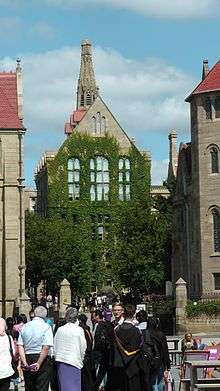The Beyer building (University of Manchester)
The Beyer building is part of the Old Quadrangle, of the University of Manchester, on Oxford Road in Manchester. The quadrangle comprises the oldest buildings of the University and was completed in 1904, prior to the Owens College becoming the Victoria University of Manchester. The original college building on Oxford Road (now called the John Owens building) was built in 1873. The Beyer building was the second side to be completed in 1887. It was funded entirely by Charles Beyer through his will of 1876. Beyer was a well known philanthropist and co-founder of Beyer, Peacock and Company, one of the world's most famous locomotive manufacturers. He was a life governor of Owens college, actively involved in the Owens College Extension Movement, and the single biggest donor to the Extension fund, which in total raised over £100,000 (£10 million today) to construct the original building at Oxford Road.

The architect was the celebrated Alfred Waterhouse (Waterhouse also designed the Natural History Museum in London).
The building was designed to house the natural sciences (Biology, Geology) departments. It also featured state of the art laboratories and lecture theatres.
It connects to the Manchester museum (the third side of the Quadrangle), which was also built in 1887, also by Waterhouse. This allowed students to access the many specimens from the museum.[1][2][3]
References
- ↑ Thompson, Joseph (1886). Owens College: Its foundation and growth and its connection with the Victoria University, Manchester. J E Cornish.
- ↑ Hartog, Phillip Joseph (1900). The Owens College, Manchester;a Brief History of the College, and description of its various departments. Manchester: J E Cornish.
- ↑ "University of Manchester website.".